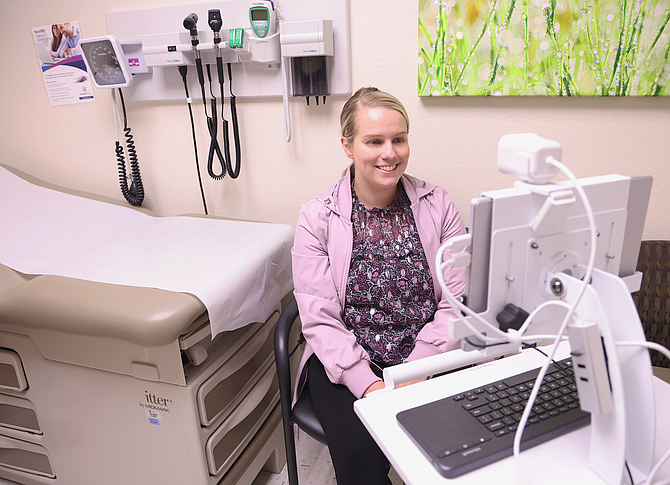Logging on for health care

Kootenai Clinic Rheumatology patient, Stephanie Vickhammer, meets with her rheumatology provider through virtual care.
COEUR d’ALENE — Logging on to use local telemedicine options from home or during a work break is just an internet connection away.
Telehealth has long been an option in some form or another, but shot up in growth as the early days of the pandemic shifted priorities for health care.
Kanan Silvas, regional medical director of virtual care for Kootenai Health, first got involved in telehealth when he was a resident in Pittsburgh. When he returned to Kootenai County in 2020, he experienced a seismic shift as virtual medical care took on added importance.
“Rapidly overnight, it shifted to telehealth overnight when all the clinics were closed. When I came in, they asked me to develop their telehealth program and help determine the structure of the program, what it looks like and see where the future of telehealth is,” Silvas said.
Many of the current projects that Kootenai Heath’s virtual care program takes on are geared toward improving access for rural patients.
“We think of it not as a separate service line, but as a tool so that you can get your regular care as you usually would. If sometimes you need to come into the office and sometimes you need a telehealth visit for a checkup, that’s fine. The most important thing is that it’s with the doctors that you know and you trust,” Silvas said.
Silvas cited a national trend of health care providers leaving the industry in the years following the onset of COVID-19 and said that supplemental care through telehealth has helped keep specialists on hand for residents. The hospital system's virtual care program has made it its mission to make sure that patients don’t lose access to services. Rheumatology has been one area where specialists outside the local community are linked in to provide care.
It can cut down on a drive or save patients with mobility issues or older patients from the complications involved in having to drive to Seattle, for instance, for an appointment with a specialist at the University of Washington.
“I just think it’s really neat, maybe because I’m a younger doc,” Silvas said. “Any time you can make care easier for patients, any time you can save them a visit is good.”
Many of Kootenai Health’s patients frequenting the virtual care program are located in rural pockets of the community, which Silvas said poses its own issues.
“The hardest thing about getting access to patients in rural areas is the internet. They don’t have great internet out there, so a lot of things we’ve been trying to do is set up the calls from the rural primary care physicians. Even if you don’t have great internet at home, you can come in to your regular doctor and see a specialist,” Silvas said.
That particular iteration of telehealth has been around for decades and helps health care providers better control the variables in making health care effective from a distance, and it is reimbursed by insurance. It’s a little bit more effort than a doctor’s appointment via video conferencing from your home, but not much more.
“That way, we can make sure that it works all the time,” Silvas said. “We always want to make things equitable and make sure that all patients have access. If you don’t have smart technology or solid internet, then it’s going to work. That way, you get wraparound services with your primary care office.”
Though the demand for telehealth has decreased from the high volume during 2020, Silvas said insurance companies have reflected that need by reimbursing telehealth visits.
“I’ve been very pleased with the amount of telehealth that has continued. It’s less than it was during COVID, but it’s still quite a bit,” Silvas said.
Contact the appointment center at Kootenai Health for virtual care at 208-625-6767.
• • •
By the numbers
There were 11,984 total patient virtual care appointments between Sept 2022 and Aug. 2023 through Kootenai Health.
Age of patients using virtual care
236 patient visits involved newborns to age 17
1,352 patient visits involved ages 18 - 30
3,189 visits involved patients ages 31 - 50
2,089 visits occurred for patients between ages 51-60
2,494 visits took place for patients 61-70
1,958 visits occurred for patients ages 71-80
657 took place for ages 80 and older
Source: Kootenai Health










